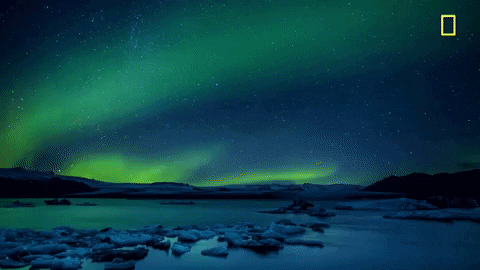The northern lights, or aurora borealis, is a display of natural light that occurs in the Earth’s sky. What you might not know is that there is another light show on Earth called aurora australis, which occurs in the southern hemisphere. So, what causes these natural and captivating lights? Solar winds are a stream of charged particles given off by the sun. During a coronal mass ejection, these winds are stronger and have more energy when they reach Earth. When a solar wind approaches Earth, it is funneled toward the poles by Earth’s magnetic field. The charged particles then collide with the atoms and molecules in the atmosphere and excite them. This causes the molecules to release photons, which we see in the sky as the colored lights. The color of the lights depends on what type of gas is excited by the solar particles because each gas has its own emission spectrum. What is also interesting is that the altitude of the gas also impacts the color. For example, oxygen at high altitudes gives off a red color, while at lower altitudes, it gives off a green one. Other planets give off auroras too! Any planet with an atmosphere and a magnetic field can emit an aurora. Auroras on Jupiter and Saturn have been documented.
Understanding Auroras: The Physics of Earth’s Magnetic Light Shows

One response to “Understanding Auroras: The Physics of Earth’s Magnetic Light Shows”
Hey Garret,
Your post on “Understanding Auroras: The Physics of Earth’s Magnetic Light Shows” offers a fascinating insight into the natural phenomenon of auroras. You did an excellent job explaining the mechanisms behind both the northern lights (aurora borealis) and the southern lights (aurora australis).
I particularly appreciated your explanation of how solar winds interact with Earth’s magnetic field to create these captivating displays of light. The way you described the collision of charged particles with atoms and molecules in the atmosphere, resulting in the release of photons, was both clear and informative.
One aspect that caught my attention was your explanation of how the altitude of the gas impacts the color of the auroras. It’s intriguing to learn that oxygen emits a red color at high altitudes and a green one at lower altitudes. This detail adds depth to my understanding of auroras and highlights the complexity of the phenomenon. Additionally, your mention of auroras on other planets, such as Jupiter and Saturn, expanded the scope of the topic and made it even more engaging for me.
Great job!!
LikeLike